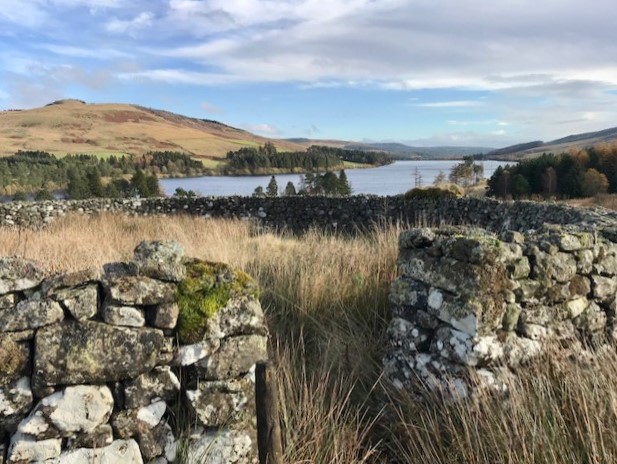Catcleugh – Revealing the Moor
Other pages you may like :
- Battle of Otterburn
- Benshaw Moor Nature Reserve
- Bremenium
- Carter Bar North
- Carter Bar South
- Catcleugh reservoir
- Corsenside
- Elsdon church
- Elsdon welcome
- Holy Trinity Horsley
- Mural at Rochester Roundhouse
- Otterburn Mill - Farming & History
- Otterburn Mill - Welcome
- Ottercops
- Redesdale Forest, Byrness and Blakehopeburnhaugh
- Ridsdale - Welcome
- Ridsdale Ironworks
- Rochester Roundhouse - Defending & protecting
- Rochester Roundhouse - Shaping and Revealing Redesdale
- St Cuthbert's Well
- St Francis Byrness
- Star Cairns
- West Woodburn
More about Whitelee Moor National Nature Reserve

Whitelee Moor is recognised as a Special Area of Conservation (SAC) thanks to its blanket bog and heather heaths. The wider National Nature Reserve has been designated both an SAC and a site of special scientific interest (SSSI). It forms part of a larger area known as the Border Mires, Kielder and Butterburn Special Areas of Conservation. It is owned and managed by Northumberland Wildlife Trust.
Blanket bog is a type of peatland which is only found in a few places in the world, often where the climate is cool and wet. These conditions encourage plants like bog mosses and cotton grasses to grow which, when they die, break down very slowly to form layers of peat which can be up to eight metres deep.
On the lower slopes of Whitelee Moor you’ll find the heather moorland. The heather’s delicate pink flowers appear from August to October and this area is home to wildlife including buzzards, peregrine falcons, the small heath butterfly and the northern eggar moth.
Wildlife in Redesdale
Redesdale’s wild and rugged landscapes of grasslands, bogs and mires provide the perfect habitat for wildlife to thrive.
Cattle and sheep craze the mosaic rushy pastures throughout the year, whilst curlews and lapwings flourish in the wetter areas of land.
If you walk across the fells around Carter Bar and Whitlee you might see a herd of feral goats which were first brought to Britain in Neolithic times. The feral goats in Northumberland are some of the best examples of this primitive goat. Herds of feral goats can also be found in hilly areas of Ireland, Scotland, Wales and other parts of England.
And if you look up to the skies you’ll be able to see some spectacular birds of prey, including hen harriers, buzzards, merlins and peregrines, which all share the Redesdale landscape.
Bat species, including pipistrelles, brown long-eared, whiskered/Brandt’s and Natterer’s bats, have been sighted in trees and buildings and structures across Redesdale. The valley is also an important site for reptiles and amphibians, with significant populations of adders and common toads based in the area.
The River Rede supports a wide range of wildlife, many of which are threatened or protected species. Together with the North Tyne, the River Rede is one of the only places in England currently supporting a significant population of freshwater pearl mussels. Otters – a European protected species – are also widespread along the river and its tributaries.
Migratory Atlantic salmon and brown trout thrive in the waters of the River Rede and the wealth of fish in the river support the population of kingfishers, dippers and herons.
Despite being a military training area, the Otterburn ranges are a haven for wildlife. Barn owl nesting boxes at Otterburn Camp have led to an increase in barn owl chicks. Merlin, buzzards and black grouse can also be found across this remote area of the National Park.
The feral goats of Whitelee Moor
If you’re lucky, you may spot Whitelee Moor’s resident herd of feral goats, particularly near the border with Kielderhead.
These wild goats are not native to Britain, but they have been here for thousands of years, having been brought here by farmers in neolithic times.
There are various theories around the origins of the goats you see in Redesdale today – for example, they may be descended from domesticated herds which were allowed to go wild when sheep overtook goats as the favoured livestock for farmers. Or they might be linked to the goats which were owned by the monks of Lindisfarne, and then released when the monastery closed.
From mid-February, you may see young goats (called ‘kids’). If you spot a kid on its own, leave it well alone; the mother goats often leave them unattended while they graze.
A team at Newcastle University has been tracking some of Northumberland’s feral goats using GPS collars, to find out more about where they roam, and to minimise the possibility of any issues caused by the proximity between the goats and active farmland.
The Lost Redesdale project
Redesdale contains a rich diversity of historic remains from Neolithic farming communities and Roman military occupation through to 19th century industry and First World War practice trenches.
The Lost Redesdale project aimed to better understand and tell the landscape story of Redesdale, investigating its cultural heritage with local people through archaeological research and sharing the stories uncovered through creative interpretation.
Find out more about the Lost Redesdale project here.